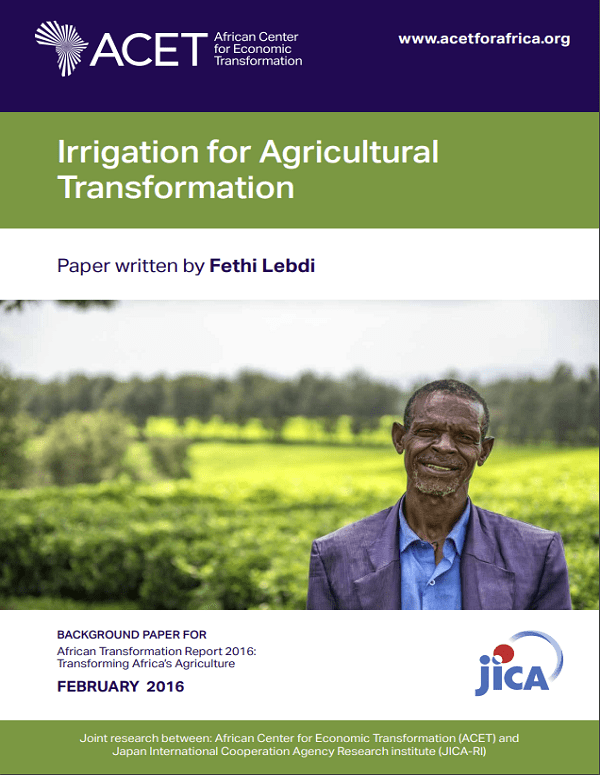This paper discusses irrigation as a major contributor to the transformation of African agriculture in order to address the challenges of ending hunger, reducing poverty and vulnerability, improving livelihood and resilience to extreme events and climate change as underlined in the main official documents like CAADP (AU, NEPAD), African water vision 2025 and AU agenda 2063; and countries’ strategies and plans.
The paper argues that, to ensure the contribution of irrigation to African agricultural transformation, several challenges need to be taken into consideration:
- Climatic uncertainties and change; water and land resources scarcity, soil fertility and the sustainability in use; cultural, socio-economic factors; technical skills, institutional capacities, irrigation backed by value chain activities, market accessibility and services;
- Capacities of countries to undertake heavy investments in the irrigation sector.
The paper examines the current situation and future developments of the irrigation sector in Africa and the trends according to agro-ecological typology and according to the main factors and issues:
- Increase of imbalance between food production and demand.
- Water supply scarcity and strategy: It categorizes water scarcity into three dimensions: scarcity of water quantity and quality, scarcity of water infrastructures and scarcity of services and capacities.
- Since transboundary water resources require agreements at different levels, water supply plans from inland water resources could be strengthened for irrigation development. Geographical water transfer (temporal and spatial) needs to be studied.
- Competition for water accessibility between economic sectors will increase in a context of water scarcity.
- It is obvious that because agriculture is still the main employer in Africa and the development of irrigation oriented to markets and services is a promising option to sustain employment and to stop rural-to-urban migration, the competition between irrigation and other water uses will take into account social and economic effects and require massive investments in the irrigation sector.
- Total water allocation for irrigation may continue to increase, but production needs will increase faster. For irrigation, this means water allocation per unit (per ha) will decrease, so water use efficiency will have to increase.
- To cultivate year-round and to stabilize production, irrigation needs to be accompanied by smart agriculture measures (soil fertilization, crop rotation and adapted/selected seeds).
- Small farm size will call for special strategies oriented to small farmers. Organization and capacity building of users will be required for efficient operation and maintenance.
- In terms of policy, a Master Plan for Irrigation is required at national and basin levels.
- In Africa, more than 78 percent of irrigation land is irrigated from surface water, against almost 20 percent of water from groundwater. Developing ground water knowledge and its use in conjunction with surface water will be required to address droughts.
- Extension, capacity building of smallholders and their access to investment in farm-level irrigation (despite land tenure constraints), and support for access to irrigation technological packages at farm level will be needed to address the low development and preparation of land for irrigation.
(xii) Since around 80 percent of farmers are smallholders, commitment of governments to heavy investments in modern irrigation equipment will be needed (drip and sprinkler irrigation systems are subsidized in many countries with public-private partnerships). Financial and technical empowerment of farmers is needed to enhance ownership of operation and maintenance and to ensure cost recovery of irrigation investments and services. - Based on areas that are economically viable for irrigation, the World Bank (Africa Infrastructure Country Diagnostic, 2008) estimates that the total irrigation investment needed in Africa comes to more than USD 40 billion (large and small scale plus rehabilitation of existing systems).
- Like in East Asia (1970s and 1980s) and North Africa (1970s and 2000s), if up to 50 percent of agricultural expenditures are diverted to agricultural water management (Horizon 2063), then Sub- Saharan Africa’s full irrigation potential could be realized over a 50-year time horizon (Ref: Liang Zhi, World Bank, 2008).
- Heavy investment in irrigation requires involvement of potential stakeholders and partnerships with the private sector. Currently, most investment in large scale irrigation systems is from the public sector. For small scale irrigation, it is essential to have individual or community level financing with public subsidies for main infrastructures and heavy maintenance (water storage reservoirs, deep wells, main water supply scheme).
- Every irrigation system once in operation has positive and negative consequences, which require accompanying measures (salinization and pollution, water logging and drainage, diseases, inequity etc).
Africa has great opportunities to overcome the current challenges hunger and food insecurity by transforming agriculture through irrigation development. This will require, in particular:
- Road Map for water supply strategy as a part of national development planning, entailing multi-purpose water infrastructure systems for inter-annual management at the national and trans-boundary levels;
- An Irrigation Sector Policy and a Master Plan that respond to the agricultural transformation objectives and aligned to National Investment Plans;
- National and Sub-regional capacity building programs focusing on irrigation on institutions (public and non-public) to enable effective policy implementation; create or reorient at sub-regional levels centers for irrigation experiments and equipment homologation, linked to research and experimentation institutions;
- Creation, rehabilitation and modernization of irrigation systems constitute the main components for irrigation investment strategy, including mechanisms for participatory irrigation management, transfer of maintenance and operation and partnership with private sector;
Promote a program of water demand management and water saving and accounting, to stimulate private sector involvement, enhance step-by-step cost recovery, and integrate environmental component and gender mainstreaming.
Download Publication Read Publication


